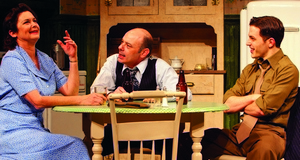SITE GUIDE
SEARCH
REVIEWS
REVIEW ARCHIVES
ADVERTISING AT CURTAINUP
FEATURES
NEWS
Etcetera and
Short Term Listings
LISTINGS
Broadway
Off-Broadway
NYC Restaurants
BOOKS and CDs
OTHER PLACES
Berkshires
London
California
New Jersey
Connecticut
DC
Philadelphia
Elsewhere
QUOTES
On TKTS
PLAYWRIGHTS' ALBUMS
LETTERS TO EDITOR
FILM
LINKS
MISCELLANEOUS
Free Updates
Masthead
Writing for Us
A CurtainUp New Jersey Review
The Subject was Roses
|
You moved me this afternoon.. . .when you brought the roses, I felt something stir I thought was dead forever. (regards the roses on the floor) And now this. . .I don't understand. — Nettie I had nothing to do with the roses. . .They were his idea. — John |

(L)Stephanie Zimbalist (C) Lee Sellars (R) Chris Wendelken
(Photo credit: T. Charles Erickson ) |
All this is to say that Frank D. Gilroy's Pulitzer Prize and Tony Award-winning 1964 drama The Subject was Roses is being revived by the George Street Playhouse mainly because, as the theatre's artistic director David Saint stated on opening night, that he has always had a fondness for it and has always wanted to do it. I suspect that's reason enough. It can't be denied that Gilroy's play has a kind of built in honesty and integrity that keeps it from being too conspicuously dated. But dated it is, in both its dramatic effectiveness and its content.
The 1968 film version (which I re-watched recently,) despite some wonderful performances by Jack Albertson, Martin Sheen (recreating their stage roles) and Patricia Neal, has an ingrained artificiality, a quality that I can now presume to be inherent in the play. However, this production under the direction of Michael Mastro is probably as fine an accomplishment as an audience could expect.
Although Mastro is more widely known as an actor, particularly for his memorably eccentric performances at George Street in The Sunshine Boys, The Pillowman, and Inspecting Carol, his debut at this theatre as a director validates the extension of his talent. He is also lucky to have three fine actors — Lee Sellars, Chris Wendelken and Stephanie Zimbalist - under his guidance. As his approach appears confined to the basic needs of this "kitchen sink and sofa drama," we could say there are no missteps from beginning to end.
Tenderly realistic with barely a trace of contrivance The Subject Was Roses focuses on the tensions and misunderstandings that arise between the three members of the Cleary clan. Timmy (Wendelken) a 21 year-old soldier has returned to his parents' Bronx apartment in 1946. Things, as you might expect, progress steadily from welcoming to woebegone before they are resolved. Essentially, this is one of those morning-after-the-night-before plays in which the playwright reveals the schisms that prevent the co-existence of three basically decent, but incompatible, members of one family. As the play points out, it takes more than a token bouquet of roses to heal long-standing hurts.
The Clearys have never been a harmonious team, but over the course of two days they are forced to face the changes in their relationship to each other and learn to respect each other — flaws and all. That their flaws don't even come close to defining what we now consider aspects of a dysfunctional family is almost the play's saving grace. Perhaps it is a play that's a trifle naie for modern audiences; yet the 48 hours during which the mother and son, the father and son, and the husband and wife all have a go at each other, vibrates with three portrayals that unquestionably convey the essential and underlying dignity of the family unit and of the human spirit.
While many in the audience will likely remember Zimbalist as Laura Holt in the successful television series Remington Steele (1982 - 1987,) it is good to see her adding George Street Playhouse to her numerous regional stage appearances. It doesn't take us long to see and understand the source of Nettie's deep affection for her son and also the need she has to fearlessly express it. She also makes Nettie's mood swings palpable as she is dragged back into the reality of her unhappy marriage. This is all expressed simply and powerfully in Zimbalist's disquietingly impassioned performance. There were moments for me (because of a subtle resemblance) that I felt as if I was watching the great and late Colleen Dewhurst burn the waffles; she also gets to burn up the floor dancing the polka with her son Timmy.
Wendelken is a fine young talent whose acting credits will assuredly increase following this impressive debut here as Timmy. He makes him not only credible as a nervous, insecure and conflicted victim of his parents' loveless marriage but also as a very decent young man who is also willing to sacrifice himself as a mediator.
It never ceases to amaze me how a familiar play with just a few actors can be shifted slightly in its orbit by one performance that is so resolutely on target, so impeccably detailed and so refreshingly feisty that it makes the entire play resonate anew. This is what Sellars does with the role of John, the intolerably argumentative and pathetically defensive father who is not able to reconcile his own failure with the divisiveness in his family. Sellars, who was comically sinister as the good cop in The Pillowman at George Street, and played Officer Krupke in the recent Broadway revival of West Side Story, essentially holds and tightens the reins on a drama that makes clear that, as Timmy puts it quite succinctly, "We are just going around in circles. "
All the production elements are first rate. Michael Schweikardt's mid-forties middle class Bronx apartment setting: (artistically illuminated by lighting designer Christopher J. Bailey) the kitchen with its familiar (to some of us) appliances, the living room with its well-worn furnishings, and the Welcome Home Timmy banner add to the reality, as do Esther Arroyo's period perfect frocks for Zimbalist.
Gilroy, despite an auspicious debut as a playwright with Who'll Save the Plowboy in 1962, never wrote another play to exceed or even match the artistic success of The Subject Was Roses which opened at the Royale Theatre on Broadway on May 25, 1964 and closed on May 21, 1966. During its 832 performance run, it was moved to an unprecedented four more theaters. Despite good reviews, until it was awarded the Pulitzer Prize for Drama in 1965 it struggled at first to find an audience and played to mostly half-filled houses. The original Broadway cast included Irene Dailey, Jack Albertson (Tony Award) and Martin Sheen, under the direction of Ulu Grosbard.
Editor's Note: There have been several other revivals of this play in the recent past. The most newsworthy of these was a 2009 production at the Mark Taper in Los Angeles. It marked the return of Mark Sheen to the play, this time as the father instead of the son. To read the review go here. A year later, it was done by New York's venerable Pearl Theater. To read that review, go here.
.
|
The Subject Was Roses By Frank D. Gilroy Directed by Michael Mastro Cast: Lee Sellars (John Cleary), Chris Wendelken (Timmy Cleary), Stephanie Zimbalist (Nettie Cleary) Set Design: Michael Schweikardt Costume Design: Esther Arroyo Lighting Design: Christopher J. Bailey Sound Design: Christopher J. Bailey Running time: 1 hour 50 minutes including intermission George Street Playhouse, 9 Livingston Avenue, New Brunswick, NJ (732)246-7717 Tickets ($29.00 -- $67.50) Performances: Tuesdays through Fridays at 8 PM; Thursdays and Saturdays at 2 and 8 PM; Sundays at 2 and 7 PM. Previews began 02/08/11 Opened 02/11/11 Ends 03/06/11 Review by Simon Saltzman based on performance 02/11/11 |
|
Subscribe to our FREE email updates with a note from editor Elyse Sommer about additions to the website -- with main page hot links to the latest features posted at our numerous locations. To subscribe,
E-mail: esommer@curtainup.comesommer@curtainup.com
put SUBSCRIBE CURTAINUP EMAIL UPDATE in the subject line and your full name and email address in the body of the message -- if you can spare a minute, tell us how you came to CurtainUp and from what part of the country. Visit Curtainup's Blog Annex For a feed to reviews and features as they are posted add http://curtainupnewlinks.blogspot.com to your reader You can also contact us at Curtainup at Facebook . . . Curtainup at Twitter Visit Curtainup's Blog Annex You can also contact us at Curtainup at Facebook . . . Curtainup at Twitter |
|
REVIEW FEEDBACK Highlight one of the responses below and click "copy" or"CTRL+C"
Paste the highlighted text into the subject line (CTRL+ V): >Feel free to add detailed comments in the body of the email and state if you'd like your comments published in our letters section. . .also the names and emails of any friends to whom you'd like us to forward a copy of this review. You can also contact us at Curtainup at Facebook or Curtainup at Twitter and Curtainup's Blog Annex |





